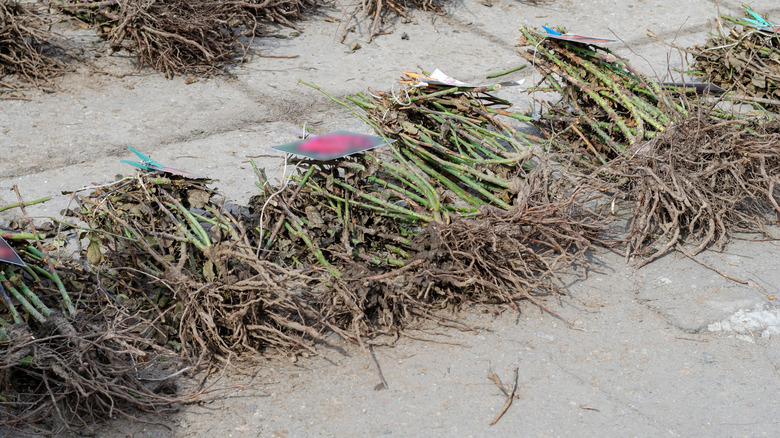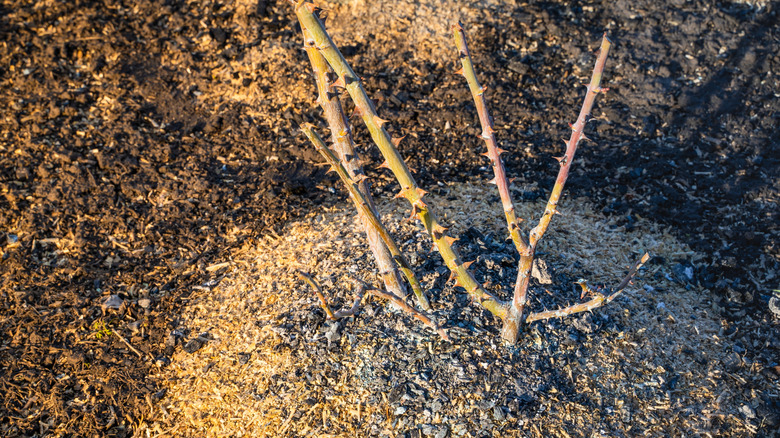The Affordable Way To Add Rose Plants To Your Garden During The Dormant Winter
Do you want to have a beautiful rose garden but hesitate at the springtime price tag for potted plants? If you live in a location where the ground doesn't stay frozen throughout the winter, there's a way to skip the expensive cost of rose plants: buying bare-root roses. This budget-friendly strategy allows you to grow your rose bush collection while the plants are completely dormant, giving you everything you need to know to plant bare-root roses. This window typically runs from late autumn through early spring, generally November to March, and is an excellent time to add these plants to your garden.
Bare-root plants are different from container-grown ones because they are shipped without any soil around their roots. This reduces shipping weight and makes them cheaper, with a wider selection than what you might find at a local garden center. The beauty of this method is in planting the roses while they're dormant, which allows their root systems to settle in over the colder months, ready to grow when the weather warms. This growing practice works well for gardeners in mild climates, such as in USDA Hardiness Zones 8 and above, or in other regions where the ground doesn't remain frozen for long periods. Gardeners must be able to work the soil soon after receiving the plants, so this method is best for regions with mild winters.
How do you store and prepare bare-root roses when planting is postponed?
Getting your bare-root roses during their dormant window means you need a plan for temporary storage, especially if you live in an area that might get some cold snaps or if planting needs to be postponed due to heavy rain. Remember that bare-root rose planting relies on the ability to plant them during this late fall to early spring period. If you can't get them into the ground as quickly as possible, temporary storage is needed to keep the roots hydrated and viable and to protect your roses from frost.
The first step you need to take is to prevent the roots from drying out, which is the most common reason these roses fail. You can keep them in their original packaging and store them in a cool, dark place—such as an unheated garage or basement — at 35 to 42 degrees Fahrenheit for up to a week. For delays longer than a week or two, you may need to heel-in the plants. This involves laying the rose on its side and covering the roots with loose, moist soil until outdoor conditions allow planting.
Regardless of how long they're stored, before they're planted, the roots need rehydration. Soak the entire root system in a bucket of plain water for at least two hours or up to 24 hours, just before placing the plant in its new home.
What's the right method for planting bare-root roses to encourage growth?
Starting the planting process the right way makes sure the dormant rose has the best chance to survive once spring arrives. Begin by finding a spot that gets between six and eight hours of direct sunlight each day. Dig a large hole at least twice as wide as the rose's root system, which may mean a width of two feet or more. Use a pitchfork to gently loosen the sides of the hole, especially in clay soil, to help the roots spread out easily. Once the hole is ready, you should add well-rotted compost or manure, then create a small cone or mound of this mixed soil in the center of the planting hole.
This mound lets the rose's roots drape downwards, splaying out around the cone. When positioning the plant, make sure the bud union — the point where the stem was grafted onto the rootstock — is set at or just below soil level. Carefully fill in the hole with amended soil, pressing it down gently to get rid of air pockets. Right after planting, give the rose a deep watering to settle the soil around the roots. The final step involves pruning the canes by cutting them back just a few inches. This cut helps because it encourages the plant to produce strong new growth in the spring, when you should be following some important early spring care tips for roses.


